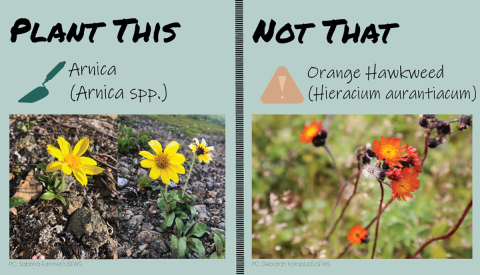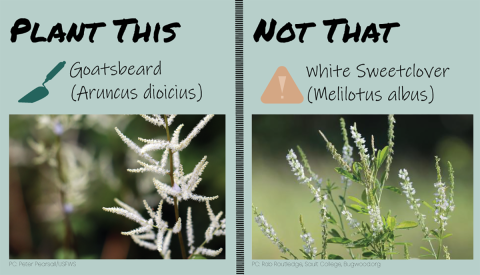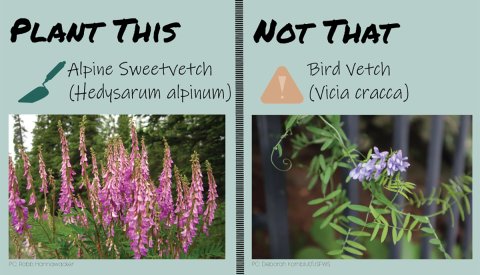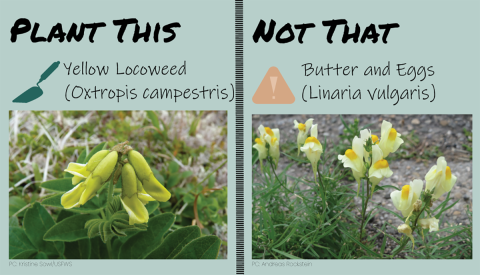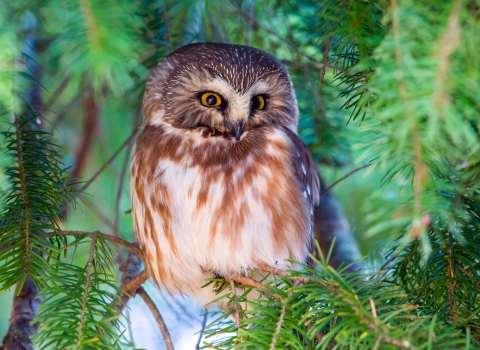It’s never too early to start thinking about what to plant in your garden, yard, or apartment balcony. You might have a specific plant in mind, whether it’s something to harvest later in the season or a vibrant flower to bring a splash of color into your outdoor space. Maybe you’re willing to buy a seed mix and just see what happens.
But have you considered if what you’re planting helps or hurts your neighborhood wildlife? Is it an invasive species invasive species
An invasive species is any plant or animal that has spread or been introduced into a new area where they are, or could, cause harm to the environment, economy, or human, animal, or plant health. Their unwelcome presence can destroy ecosystems and cost millions of dollars.
Learn more about invasive species ?
This or that?
An invasive plant is more than just a weed that you don’t want to grow.It’s one that is likely to outcompete the plants growing around it, escape beyond its designated space, and may cause damage in terms of the environment, economy, or even human health. Once an invasive plant is introduced, it’s increasingly difficult to remove. Gardening is a common path for invasive plants to be introduced to Alaska.
On the other hand, you can choose a plant that has evolved with Alaska’s other flora and fauna. Choosing to grow a native plant benefits the insects that have lived with these flowers for generations, feeding on their pollen and nectar. Native plants also feed animals and provide shelter and nesting for birds and insects. The native fruits and seeds from your garden help keep Alaska’s lands and waters healthy.
Here are five plants to avoid and the beautiful alternatives that you can plant instead:
1) You say chokecherry, I say serviceberry
First off, we have a tree of many names. ❌Chokecherry trees❌ are also commonly referred to as European bird cherry and Mayday trees. These trees are currently found in Anchorage, Homer, Hope, and Talkeetna. In fact, we are talking about two related, but different, species: Prunus padus and Prunus virginiana. Both trees grow quickly, shade out surrounding vegetation and reduce the quality of food available for moose. In bloom, chokecherries have aromatic white flowers that eventually turn into small black fruit. These berries may be edible to humans but can be toxic to moose and have even led to moose deaths.
You say chokecherry, I say ✔️serviceberry✔️ (Amelanchier alnifolia or A. florida). Although not technically a tree like chokecherry, this shrub can grow up to 12 feet tall with delicate white flowers. In the fall it grows abundant sweet berries, and the leaves turn vibrant colors. Plant this in your garden and you provide the service of feeding the neighborhood birds. Enjoy watching yellow warblers, bohemian waxwings, and other songbirds flock to your garden for food. You can also eat these berries, which can be dried, jammed, or turned into pies.
2) Out with orange hawkweed, in with arnicas
Like other plants on this list, ❌orange hawkweed❌ (Hieracium aurantiacum)was brought to Alaska as an ornamental plant. Orange hawkweed often grows in sunny spots near areas with human activity in Southcentral and Southeast Alaska. There are currently no known orange hawkweed infestations in Interior Alaska. Don’t be the one to introduce it, that’s not a reputation you want!
The stems of orange hawkweed are mostly leafless, but its bright orange flowers grow in clusters of 5–30 which may make you think that this plant will bring a welcome splash of color to your garden. Unfortunately, you will quickly be seeing orange everywhere. Orange hawkweed creates very dense mats that release a chemical, preventing other plants from growing and decreasing food availability for other animals like pollinators or grazing animals. Mowing orange hawkweed only promotes its growth.
If you are wondering how to bring vibrant colors to your yard without the wildlife woes, there is good news! Orange hawkweed has a much more Alaska-friendly cousin. ✔️Arnica✔️! Arnica is a flowering plant in the daisy family (Asteraceae), just like orange hawkweed. This means they share the same distinct sunflower-shaped bloom. In Alaska there are many types of arnicas (Arnica spp.). They vary based on the region they grow, from meadows to the alpine. Yet they all produce rich yellow blooms which may light up your garden from June to August. Ask your local plant nursery about the varieties of arnica available.
3) Trade white sweetclover for goatsbeard
You’ve probably seen ❌white sweetclover❌ (Melilotus albus)growing in Southcentral and Interior Alaska along roadsides and other places with human activity. At first glance, this may seem like a useful plant to keep around because it adds nutrients to the soil, and its aromatic white flowers are attractive to pollinators.
However, a single white sweetclover can produce up to 350,000 seeds which can remain viable for up to 81 years. Its abundant seed production allows white sweetclover to spread rapidly and persist despite removal efforts. White sweetclover changes soil chemistry which affects what else can grow in the area. This invasive plant also grows up to 6 feet tall, shading out surrounding plants. These traits make white sweetclover a powerful competitor for the resources native plants depend on.
Thus, we suggest the dashing ✔️goatsbeard✔️! Goatsbeard (Aruncus diocius) is a tall plant with floofy, cream-colored flowers that bloom in July. These blooms attract many pollinators such as butterflies, bees, and flower flies. Goatsbeard transplants well into moist, rich soils and will come back year after year without the side effects of white sweetclover.
4) Goodbye bird vetch, hello alpine sweetvetch
Next on our “don’t plant” list is ❌bird vetch❌ (Vicia cracca). Known for its bluish-purple flowers, we often find bird vetch growing in grassy areas alongside trails, roadways, and sometimes intentionally propagated in somebody’s yard. But watch out, bird vetch is the Houdini of the plant world. It has a history of escaping into the wild, spreading quickly, and taking over! Unlike other climbing plants in Alaska, bird vetch has distinct stems and tendrils that enable it to climb any upright object, whether that be a fence, a tree such as an alder or willow, or your house. Like white sweetclover, bird vetch flowers will compete with native plants for pollinators and change soil conditions.
There is an equally attractive native alternative to bird vetch that comes without the consequences. Goodbye bird vetch, hello ✔️alpine sweetvetch✔️ (Hedysarum alpinum). Alpine sweetvetch and bird vetch are both in the pea family, so they share the same beautifully shaped flowers. But with alpine sweetvetch, you won’t have an escape artist on your hands.
Alpine sweetvetch supports many Alaskan animals: from the birds that nest in its greenery to the bears and sheep dig up and eat its starchy roots. Alpine sweetvetch is also collected and eaten by Yup’ik, Iñupiaq and Dena’ina Athabascan peoples. The many names of alpine sweetvetch include Marralaq or Masru (Yup’ik), Masu (Iñupiaq), and K’tl’ila (Dena’ina).
5) Swap butter and eggs for yellow locoweed
While the name might sound tasty, ❌butter and eggs❌ (Linaria vulgaris) is a very harmful plant to keep around. Sometimes known as toadflax or wild snapdragons, butter and eggs is uniquely identifiable in Alaska because it has a yellow flower with an orange throat. This aggressive plant finds a spot for itself wherever the land is disturbed, but then easily moves over into neighboring undisturbed areas. Once introduced, butter and eggs will compete for moisture in the soil and spread to create very dense colonies.
Swap butter and eggs for ✔️yellow locoweed✔️ (Oxtropis campestris) in this year’s garden recipe. Yellow locoweed, or yellow oxytrope, grows low to the ground with grayish green, hairy leaves. When it blooms in late May and June, it produces small yellow pea-shaped flowers which attract many different types of bees.
Though we’re running with this food metaphor, neither of these species should be eaten. Yellow locoweed is named for the known toxin it contains and can cause grazing cattle to walk with an uneven gait.
TL:DR
When selecting plants for your garden be aware that many plants that look beautiful can cause a lot of damage. Check your “wildflower seed mixes” and make sure they are wild to Alaska. Choose native plants that are local to your area and your garden and yard will benefit the living things around you. You can be a steward for the lands we all depend on by keeping in mind the phrase “Don’t plant a problem.” Get to know what you are planting and learn more with these additional resources:
🌱 Garden with pollinators in mind! Use these pollinator garden recipe cards.
🌱 Don’t plant a problem! Look for it here first.
🌱If you find and invasive species, please report it to 1–877-INVASIV
In Alaska we are shared stewards of world renowned natural resources and our nation’s last true wild places. Our hope is that each generation has the opportunity to live with, live from, discover and enjoy the wildness of this awe-inspiring land and the people who love and depend on it.





